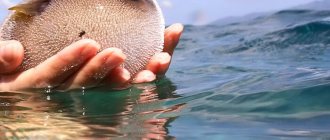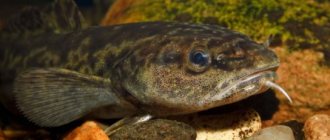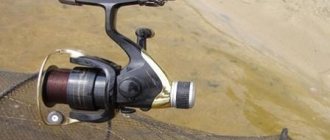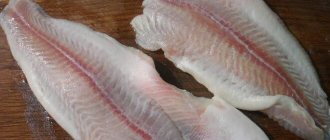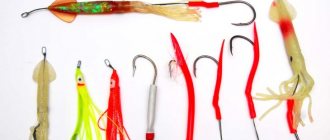Burbot
Burbot is a member of the cod family . Its peculiarity is that, unlike other species of this family - inhabitants of the sea, burbot constantly lives and reproduces only in freshwater reservoirs.
Young burbot have a dark gray color with black speckles , and then with age they lighten and acquire a yellowish tint; in addition, the color is significantly influenced by the quality of the water. It is also believed that burbot vaguely resembles catfish. It has two fins on its back (small and large), a characteristic mustache on its chin, and its body is covered with small scales deeply embedded in the skin and a large amount of mucus. As for size, individuals have been known to reach 2 meters in length and weigh 30 kg, but this is the exception rather than the rule. On average, the weight of an adult burbot ranges from 1 to 2 kilograms. At the same time, males can barely grow to half the weight of their females.
Burbot habitats
Burbot is a widespread fish . It can be found in a number of European countries, in North America and, of course, in Russia. The main habitats of burbot are rivers flowing into the Arctic Ocean . Sometimes it appears in the lower reaches of rivers in the Caspian and Black Sea basins.
Burbot is found in sufficient quantities in the reservoirs of the Leningrad region, here it can be found almost everywhere, in particular in lakes Ilmen, Ladoga, Onega, Pskov-Chudskoye, as well as in the Neva and other rivers flowing into the Gulf of Finland. The largest individuals are found in the Irtysh, on the Ob and in Pechora.
Burbot prefers clean and cold water of rivers and lakes with a rocky bottom, sometimes covered with silt . It does not like fast currents, so it reaches its maximum size in flat northern rivers and flowing lakes.
The most comfortable water temperature for burbot is no more than 12°C; when it rises to 15°C , the fish goes to places that are maximally protected from sunlight and enters a kind of hibernation, during which it may not hunt for up to several weeks.
Types of white fish
Flathead fish is a type of white fish. It is noteworthy that in ancient times it was considered the most valuable species, and fishing was extremely developed. Villages and cities were located close to bodies of water: lakes, rivers and seas. The main source of income for people in those distant times was fishing.
Today, fishing also occupies one of the leading places. White fish is of particular nutritional value and serves as the basis for preparing all kinds of dishes. Its taste and beneficial properties have brought it unprecedented popularity. In addition, unlike red, it is not such an expensive food product. Its appearance also attracts attention, and catching it becomes a very exciting activity. There are a great many fishermen hunting specifically for this species.
White sea fish has a specific light color. Its various types differ from each other in external characteristics, as well as in belonging to certain families; its main types are flat and round.
Sturgeon
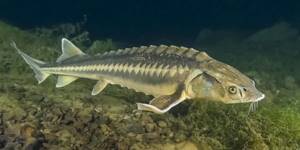
The sturgeon has an elongated, spindle-shaped body. The snout is short and blunt. The antennae are located closer to the end of the snout than to the mouth. The lower lip is broken. The dorsal fin has 27-51 rays, the anal fin has 18-33. Dorsal bugs - 8-18, lateral bugs - 24-50, ventral bugs - 6-13. The body between the rows of bugs is covered with star-shaped plates, sometimes small bone plates are scattered between the bugs.
The color varies greatly. Usually the back is grayish-black, the sides of the body are grayish-brown, and the belly is white. A large sturgeon, reaching (in the past) in the Black Sea a length of 236 cm and a weight of 115 kg, and in the Caspian Sea, respectively, 215 cm and a weight of 65 kg. The maximum size of the sturgeon, judging by the analysis of archaeological materials, is 300 cm, and its life expectancy can reach 50 years. Nowadays, the average fishing weight of Volga sturgeon is 12-16 kg, Kura sturgeon 22-24 kg and Azov sturgeon 15 kg.
The Russian sturgeon is characterized by a complex intraspecific structure: it has winter and spring forms, and within each there are smaller groups that differ in the timing of entry into rivers, the size of fish, the duration of stay in fresh water, etc.
Lifestyle
Sturgeon is an anadromous fish, although in the past a small, veiny, slow-growing form may have lived in the Middle and Upper Volga. In the sea, adult sturgeons feed mainly in shellfish fields at depths from 2 to 100 m, juveniles - at depths from 2 to 5 m. The most important role in the nutrition of large sturgeons is played by the Abra mollusk acclimatized to the Caspian Sea. In addition to mollusks, fish are also found in the stomachs of sturgeons: in the Black Sea - gobies, anchovy, sprat, in the Caspian - gobies and sprat.
Sexual maturity in most males occurs at the age of 11-13 years, in females - at 12-16 years. In the Sea of Azov they usually mature 2 years earlier than other populations. To spawn from the Caspian Sea it enters the Volga, less so into the Urals, in very small numbers it enters the Terek, Sudak, Samur, along the Iranian coast into Sefidruzh and occasionally into Gorgan, Babol and other rivers. The spawning migration of sturgeon to the Volga extends from late March – early April until November with a maximum in July. Fish of later migration spend the winter in the river. Spawning of spring sturgeon in the Volga occurs in mid-May - early June at water temperatures from 8 to 15°C.
Acne
Refers more to catfish than to snake-like fish. Among them, most are without scales. In the photo, the fish looks like a large leech. The eel has a similar mouthparts, however, the fish hunts using an electrical impulse.
Strange in appearance, living near the bottom, eels confused the ancients. Aristotle, for example, believed that serpentine fish arise spontaneously from algae. The exact nature of the origin of eels was determined only in the 1920s.
The eel is both a river fish without scales and a sea fish. Serpentine creatures are born in the Sargasso Sea in the Bermuda Triangle area. Caught by the current, the young rush to the shores of Europe, entering the mouths of rivers and ascending them. Eels mature in fresh water.
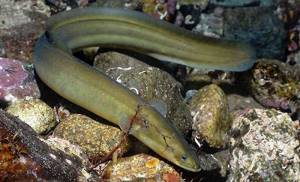
Moray eels
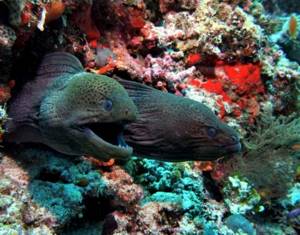
Appearance
Moray eels are a genus of ray-finned fish from the moray eel family. Found in the Atlantic, Pacific and Indian Oceans, widespread in the Mediterranean and Red Seas.
They have a length of up to 1.5 meters and a weight of up to 50 kg, but, as a rule, there are individuals about a meter long. The body is serpentine-shaped, the skin is bare, without scales. The color of moray eels is very diverse, which helps them camouflage: brown, green, greenish-yellow, spotted, striped, “marbled”.
Lifestyle
Moray eels live in the bottom layer of water, one might say, at the bottom. During the day, they sit in crevices of rocks or corals, sticking their heads out and usually moving them from side to side, looking for passing prey. At night, moray eels emerge from their shelters to hunt. They usually feed on fish, but they also attack crustaceans and octopuses, which they catch in ambush, jumping out of their hiding places like an arrow and grabbing prey swimming past.
After processing, moray eel meat can be eaten. It was especially valued by the ancient Romans. Fish bites can be dangerous to humans. Previously, their teeth were considered poisonous, but this data has not been confirmed. However, the bite of a moray eel is extremely painful. There are known cases of fish attacks on scuba divers.
Som
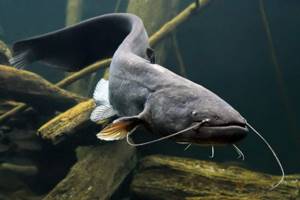
Catfish is the largest predatory fish that lives in freshwater lakes and rivers. It belongs to the class of ray-finned fish, the order of catfishes, and the catfish family.
The catfish fish is quite widespread in the waters of Europe and Asia, while living in rivers flowing into the seas, it often swims into their salty waters. Unfortunately, in such conditions, only one species of catfish can exist for a long time - the channel catfish; other individuals from this family are not adapted to such a “salty” living.
The catfish fish has a long, flattened and rather powerful body, which is devoid of scales and covered with a layer of mucus, which ensures the gliding and maneuverability of the fish in the water space. The wide head of a catfish usually has a flattened shape. There are small, slightly blind eyes of the catfish on it. The wide mouth of the fish is “armed” with small, but abundant teeth. Almost all catfish have one feature: long whiskers are located on the jaws of this predatory fish. The catfish's whiskers are the most important tactile organ with which fish find food. Depending on the variety, of which scientists number about 500, the appearance of the catfish, its color and size can vary significantly.
Nutrition
Catfish in nature prefers to lead a bottom-dwelling lifestyle, lying in pits with a large accumulation of silty sediments. It is unpretentious in nutrition: the catfish happily eats plant remains, small fish, larvae, frogs, shells, crayfish, or birds, mice and other living creatures that accidentally fall into the pond. Catfish also feed on carrion. Often he “hunts” for prey near old and forgotten fishing nets. A large hungry catfish can even eat a dog or calf that accidentally entered the water.
Types of catfish
There are many interesting and unusual representatives in the catfish family.

Catfish in an aquarium
The common (European) catfish can reach a length of up to 5 meters and weigh up to 400 kg. Lives in rivers and lakes of Europe and Russia. Cases of attacks by common catfish on people have been described.
- The American catfish (dwarf catfish) lives in the waters of South America. The length of the American catfish does not exceed a meter, weight – 7-10 kg. The mouth of this species is surprisingly designed: the teeth are arranged in several rows, and each row differs in size - from smallest to largest. This feature allows the American catfish to capture prey as if in a steel vice.
- The electric catfish lives in the reservoirs of Africa and the rivers of Arab countries. Its ability to generate powerful charges of electricity helps it successfully hunt even large prey. There is information according to which an electric catfish killed animals that accidentally wandered into a pond to drink with a discharge of current.
Among catfish, numerous aquarium varieties are widely known: ancistrus catfish, cockroach catfish, platidora catfish, glass catfish, cuckoo catfish, shifter catfish and others. And their variety of colors is simply amazing.
Why don't Jews eat fish without scales?

The book “Vayikra” says: “Eat from everything that is in the water: everything that has a fin and scales... And everything that does not have a fin and scales in the seas and rivers - they are vile to you. Do not eat their meat and abhor their carrion.”
Thus, only fish with scales and fins are considered kosher by Jews, and the rest of the inhabitants of water bodies, including mussels, oysters, squid, crustaceans, are equated to “unclean reptiles” and are prohibited by kashrut. Interestingly, black caviar is also prohibited, while red caviar is allowed.
Golomyanka
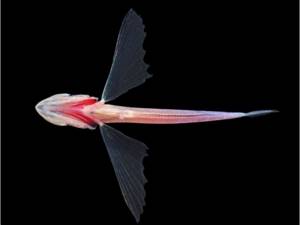
Golomyanka is a small unusual fish that lives in Lake Baikal. It is slightly pink, transparent or translucent, and also prefers deep waters and the bottom. But the lucky ones managed to film its movements several times under the ice near the surface of the lake. Fish are endemic - small local species that live only in a given area.
It is noteworthy that this Baikal fish of the Golomyankov family has no scales and one third consists of fat. This compensates for her lack of a swim bladder. Both large and small species (Dybovsky's golomyanka; named after the naturalist Benedikt Dybovsky, who discovered the fish in 1830) are most often found at a depth of 0.5 to 0.25 km, but live even deeper - up to 1.6 km.
In addition to the sizes, which gave the basis for the names of the species, there are a number of distinctive features:
- color (larger ones have a whiter body, which is explained by a large amount of white fat under transparent skin);
- the size of the eyes (in the small species d is 2 times less than the width of the forehead);
- survival rate (big ones die more often during childbirth);
- the number of males (large ones have much fewer).
Nutrition
The method of catching food is by opening the mouth and frequently biting. The main diet of the golomyanka is planktonic crustaceans of Baikal waters (Cyclops, Jurassic amphipods, Epishurs). Large individuals often engage in cannibalism within their families or among young bulls. It is interesting that the golomyanka goes up to feed at night, and during the day it hides from predators like omul or seal closer to the bottom. If fish wash ashore after a storm, they become prey for local birds.
Reproduction
The Baikal golomyanka is viviparous; it does not spawn, spawn, or migrate. All this is incredible, because in cold waters populations survive only on eggs. But the fat fish managed to overcome the forces of nature and become a legend of Lake Baikal.
Before giving birth, she rises to the level where plankton lives in order to provide food for the offspring. It was believed that fish most often die during childbirth, but later studies refuted this assumption. The large species breeds at the end of summer (the water is as warm as possible) until mid-autumn. The small species prefers spring. The presence of travelers and swimmers does not bother the fish. During the birth process, up to 2,500 larvae of the large species and about 1,500 larvae of the small species appear at a time. The sexual cycle is usually one-time.
Shark
The shark is classified as a fish that lacks hard plates on its body. She has them, but their size and shape are non-standard. In structure, shark scales resemble teeth. Their shape is rhombic. Such small “teeth” fit very tightly to each other. The body of some sharks is covered with spines over the entire surface.
Why is this predator classified as a fish without scales? Everything is very simple. The hard, jagged plates covering its body are very smooth. If you look solely at the shark's skin, you might think it belongs to an elephant.
This predatory aquatic creature is famous for its razor-sharp teeth. They are shaped like a cone. A special feature of the shark is the absence of a swim bladder. But this does not prevent it from being a full-fledged fish, since maneuvers are performed thanks to the presence of fins. This aquatic predator is classified as a cold-blooded animal.
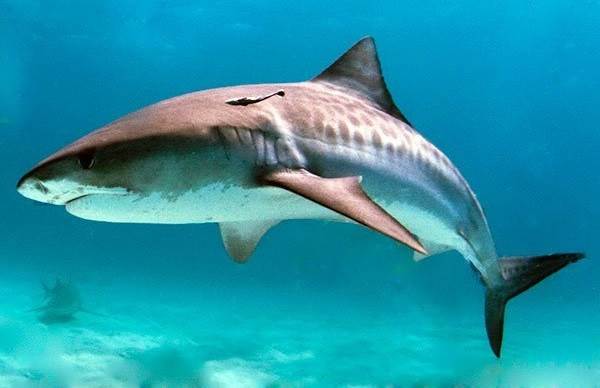
Tiger shark
Alepisaurus
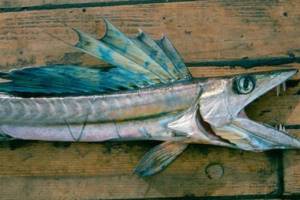
Alepisaurus is a large predatory fish belonging to the Alepisauridae family. The appearance of this creature is truly terrifying. With its large mouth with large dagger-shaped fangs, the fish resembles a daggertooth. And the huge fin makes the alepisaurus look like a sailfish.
Alepisaurs are truly creepy creatures. The toothy mouth alone is worth it. But there is also a fish body, the length of which can reach up to two meters. The body itself is narrow, its front part is slightly flattened laterally, and the tail part has a cylindrical shape. Yes, by the way, this fish really has no scales completely.
The back of the alepisaurus is decorated with a huge fin stretching along the entire body. If the fin is straightened, then it is twice as tall as its owner. The color of the fanged fish is also gloomy - black-gray-blue. There is still very little information about the reproduction of these representatives of marine fauna. But if we consider that alepisaurs are not averse to occasionally feasting on their fellow creatures, we can assume that they are generally hermaphrodites, and each individual has both female and male organs.
Story
The first mention of this sea monster dates back to 1741. Then the description of the alepisaurus was given by the famous participant of the second Kamchatka expedition, Georg Wilhelm Steller, who was lucky enough to see a specimen of a hitherto unknown fish washed ashore by a wave. Then the traveler named his find Plagyodontis. That was the end of the study of this marine inhabitant.
It was only in 1811 that interest in the alepisaurus arose again. This time, zoologist Peter-Simon Pallas, using Steller's findings and his dried find as a basis, compiled a detailed description of the fish, identifying a separate genus for it - Plagyodum. Later the name was transformed into Alepisaurus ferox, which is translated from Greek as “lizard”, “scaleless beast”.
Lifestyle
Like many fish that live in the depths, alepisaurs practice daily migrations in a vertical direction. At night they try to move closer to the surface, and during the day they return to the depths. Such “walks” are associated with the movement of food, for which alepisaurs use various types of fish, squid, octopuses and crustaceans. If food is very tight, then the predatory fish will not disdain its smaller relatives.
White shark
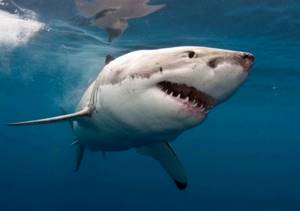
The great white shark is known to many as the man-eating shark, or carcharodon. This animal belongs to the class of cartilaginous fish and the herring shark family. Today, the population of this species slightly exceeds three thousand individuals, so the great white shark belongs to the category of predatory animals that are on the verge of extinction.
The largest of all modern predatory sharks is eleven meters or a little more in length. The most common individuals are those with a body length of no more than six meters and a weight in the range of 650-3000 kg. The back and sides of the white shark have a characteristic gray coloration with slight brownish or black tones . The surface of the ventral part is dirty white.
It is known that relatively recently white sharks existed, whose body length could reach thirty meters. Eight adults could easily fit in the mouth of such an individual, living at the end of the Tertiary period.
Lifestyle
Modern white sharks lead a predominantly solitary lifestyle. Adult individuals can be found not only in the waters of the open ocean, but also near the coastline. As a rule, the shark tries to stay close to the surface and prefers warm or moderately warm ocean waters. The white shark destroys prey with the help of very large and wide, triangular teeth. All teeth have jagged edges. Very powerful jaws allow the aquatic predator to effortlessly bite through not only cartilaginous tissue, but also fairly large bones of its prey. Hungry white sharks are not particularly picky about their food choices.
The dominance of females over males, and the largest individuals over smaller sharks predominates . Conflict situations during the hunting process are resolved by rituals or demonstrative behavior. Fights between individuals of the same population are certainly possible, but they are quite rare. As a rule, sharks of this species in conflicts limit themselves to not too strong, warning bites
A distinctive feature of the white shark is the ability to periodically raise its head above the water surface in the process of hunting and searching for prey. According to scientists, in this way the shark manages to capture odors well even at a considerable distance.
Shark
Included in fish without scales only conditionally. There are plates on the body, but they are placoid. These have spikes. They are directed in the direction of movement of the fish. In stingrays, for example, the same scales have been transformed into tail spines.
Most fish have cycloid scales, that is, smooth. Due to the placoid plates, the body of sharks looks rough, like those of elephants or hippopotamuses. Common people perceive this as the absence of scales, rather than as a special type of scale.
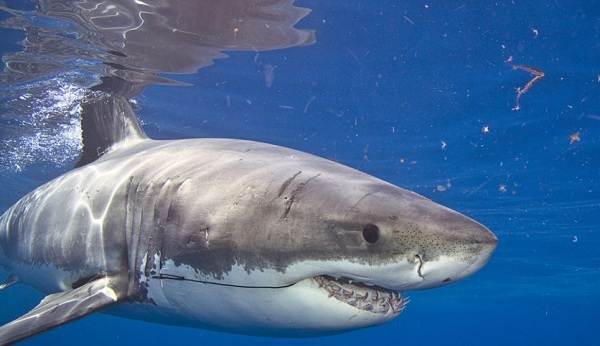
The shark has scales, but they don’t look like the ones we’re used to
Navaga
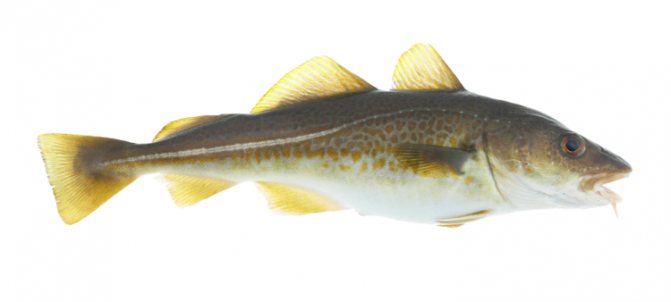
Navaga is a cold-loving sea fish; it belongs to the cod family. There are two types of this fish, northern navaga and Far Eastern, known as vakhnya . The body length of navaga usually reaches 30 cm, its weight at this length is 250 grams; there are also larger individuals, up to half a meter in length, weighing about 1 kg. The Far Eastern navaga is much larger than the northern navaga.
The body of navaga has a more rounded appearance than that of other cod, the head is smaller in size, the fish is distinguished by a peculiarity in the structure of the spine - there are peculiar swellings on its short ribs. The upper jaw of the fish is longer than the lower jaw; a single antennae is located on the lower jaw. There are many dark spots on the brown-gray back of the navaga. The sides of the fish are lighter than the back, the belly is white. The Far Eastern wahnia also has a white belly, but its back is greenish-gray and its sides are silver-violet.
Habitat
Navaga can be found from the White Sea to the Ob Bay, the Far Eastern navaga lives in the Chukchi, Bering, Okhotsk, and Japan seas. Navaga cannot be found in the open sea; it is a coastal fish. In the spring, when the water on the coast becomes too warm, it moves away from the shore a short distance in search of colder water. In the autumn-winter period, navaga moves in flocks closer to the shore; schools of Far Eastern navaga often enter lakes and river mouths. Navaga is a bottom-dwelling fish
Diet
Navaga is a predator; it feeds on eggs and juveniles of other fish, crustaceans, and various worms. In the spring, when the fish are forced to look for cold water, their nutrition is insufficient; as cold weather sets in, the navaga returns closer to the shore to fatten.
Sea eel
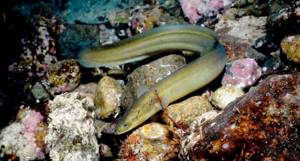
The conger eel is a fish of the eel family. The Latin name for this fish is Conger conger. There is also a second name for the conger eel – conger.
A person who sees an eel for the first time may confuse it with a ribbon sea snake, which is very poisonous. This is understandable due to the long cigar-shaped body and three fins fused into one (dorsal, caudal and anal fins). The eel's small head with large oval eyes and wide mouth complement the resemblance between the eel and the snake. The eel's outer teeth, which form the cutting edge, are well developed. The gill openings, shaped like slits, reach the abdominal part. The pectoral fins are visible immediately behind them. The skin of the eel, completely devoid of scales, is abundantly covered with a layer of mucus secreted by special glands.
The color of eels is not particularly varied and is dictated by the need for camouflage during hunting. Therefore, most often sea eels are colored in various shades of gray, black, brownish or greenish. Sometimes there are specimens with contrasting spotted coloring. In size, sea eels are significantly larger than their freshwater relatives and can reach a length of up to 3 m and weigh up to 100 kg.
Habitat
The distribution range of conger eels is quite wide and includes the warm waters of the Indian, Pacific and Atlantic oceans, as well as the adjacent seas. Some species of conger eels tolerate colder waters better and can be found in the Mediterranean and North Atlantic. The conger eel fish swims into the North, Baltic and Black Seas quite rarely. These fish are inhabitants of both the coastal zone and the open sea, never descending deeper than 500 m.
Nutrition
Eels are nocturnal and prefer to sleep in a secluded place during the day. By nature, they are voracious predators with powerful teeth. The diet is based on small fish, crustaceans and mollusks. They will not miss the catch caught in fishing nets. Lacking good eyesight, eel fish prefer to ambush prey, because thanks to their excellent sense of smell, they sense it from afar. There are species of eels that camouflage themselves with bottom vegetation. Digging a vertical hole in the ground with the help of a strong tail and leaning halfway out of it, sea eels wait for prey. In case of danger, they hide completely in the hole with lightning speed.
Flat varieties
The species has a characteristic feature: the original flattened body shape. Their main bones radiate from the back in the form of rays directed towards both sides of the ridge. It seems as if the entire upper part of this creature is its back, and the lower part is its stomach. However, it is not. Most of the surfaces are occupied, oddly enough, by the sides. Some representatives of this type of fish can reach up to two meters in length. You should understand the names of flat fish, which are the most popular today:
- flounder,
- halibut,
- whitefish,
- tilapia.
Let's look at the brightest representatives of this family.
Flounder
It is noteworthy that there are approximately 500 species of flounder fish on earth. Their habitat is very diverse: they are found both in hot tropical waters of seas and oceans, and in icy arctic ones. As a rule, they live in coastal areas, but some species can enter rivers, rising quite high in them. Some species are found at very significant depths.
There are about 30 species of flounder in the Russian seas. There are different names for flounder: salt, sole, gloss, diamond, limand. Her body looks flattened on both sides, she can gain weight up to 3 kilograms. In the upper part, where the eyes are located, the color is lighter and brighter. Mostly found at the very bottom. It is found in the Azov, Black, Bering, Okhotsk and Mediterranean seas, as well as in the waters of the Atlantic Ocean. Spawning takes place in early spring at a depth of 150 m .
One cannot help but appreciate its excellent taste, which is why the fish is caught at a very fast pace. This leads to a sharp decline in flounder populations in many seas.
Halibut
Belongs to the order of predators. It feeds on pollock, cod, flounder, and a variety of mollusks. The lifespan of halibut is about 30 years. It is one of the valuable species of commercial fish, as a result of which it is caught in unusually large quantities.
It is found in the northern Pacific and Atlantic oceans, as well as in the Seas of Okhotsk and Barents. It is divided into such varieties as black, common, Asian and American arrowtooth halibut.
tilapia
Belongs to a freshwater species. Lives at the bottom of tropical reservoirs. Tilapia is not a picky eater and feeds on all kinds of organisms in the water.
In addition, tilapia is artificially bred in North American, African and Asian countries. Its meat is rich in protein, lean, and has an excellent taste. For this, she was nicknamed the “royal perch.”
pearl fish
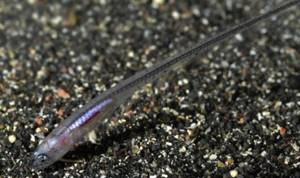
As a rule, pearl fish are called fish from the carp family, which belong to the lechefin. The history of the name of this group of living organisms is quite fascinating. One day, one of the pearl fishermen discovered a translucent snake-like creature inside the valves of an oyster. During its stay in the “house,” the fish managed to turn pearlescent, which gave the false impression that it itself had a pearl color.
Depending on the degree of independence of their existence, we can distinguish:
- Eking out a parasitic existence inside invertebrate hosts such as bivalves, ascidians, starfish and sea cucumbers. Most often, crappies choose so-called sea cucumbers as their “home” and live in their anal pores, eating their eggs.
- Having a symbiotic relationship with their owner.
- Synanthropic - use the body of another living creature as a home, but do not harm it in any way and do not benefit it.
- Free-living - this is how all “pearl oysters” live in the larval state. In this state they live among plankton. The embryos typically have a long filament in front of the dorsal fin, which has various appendages.
In 1977, a New Zealand biologist recorded about 15 species of these fish, most of which lived in the body of a sea cucumber.
Spreading
Carp live in the tropical waters of the following oceans:
- Atlantic;
- Indian;
- Quiet.
The habitat depth is quite high and can reach a couple of kilometers. A typical dwelling is located in the area of ocean slopes and gently sloping bottom.
Due to their tiny size and the almost complete lack of means to repel aggression, these fish are forced to spend a significant part of their lives inside other larger organisms.
And only with the onset of darkness their time comes, and they swim out of the owner’s body in order to feed.
This fish is practically unsuitable for food due to its tiny mass and lack of any useful substances. However, it is possible that there is a risk of accidentally eating it along with the organism in which it lives.
Loach
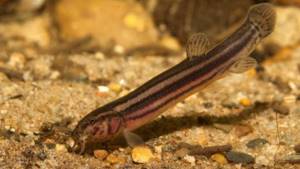
Loach is a freshwater river fish of the class ray-finned, order Cyprinidae, family Loach, genus Loach. The fish was called loach because it has a certain ability to wriggle like a snake.
The length of some types of loaches reaches 30 centimeters, but on average these fish do not exceed 15-18 centimeters. Loaches are covered with small but noticeable scales. The body is elongated, serpentine in shape. The loach is a squeaking fish: if you take it out of the water, it will begin to wriggle and squeak very strongly. The tail fin of fish from the loach family is small and has a rounded shape. The mouth has from 6 to 12 antennae. The nostrils are elongated into small tubes. Unlike females, males have a thickened and elongated second ray of the pectoral fin. There is also a thickening on the sides, behind the dorsal fin, which is formed by adipose tissue. The lifespan of loaches is about 10 years.
Habitat and species
The loach lives in the waters of Europe, as well as South and East Asia. This fish can live in any freshwater body of water where there is silt or mud. Loach is a fish that adapts very easily to its environment. If the reservoir dries out, these fish bury themselves in the silt and wait for the moment when the rains come and their habitat is filled with water again.
The most common types of loaches:
- The common spined loach is the smallest representative of the fish of the loach family. It lives throughout Europe, with the exception of Norway, Ireland, Sweden, and Scotland. It is widespread in the CIS countries, as well as in Northern China, Japan and Asia Minor. The length of this type of loach reaches only 10 cm. The main body color is light yellow, on the sides there are large spots that merge into a common stripe.
- Common loach , lives in muddy reservoirs of Europe and Asia. The body length of the common loach is from 15 to 30 cm. Its color depends on the living conditions. Basically, the back is brown, with a large number of dark spots, the belly is yellow, spotted. In the middle of the loach’s body there is a dark wide stripe, and above and below it there are narrow stripes.
- The Amur loach naturally lives in water bodies of northeast Asia, Siberia, Sakhalin, as well as in China and Japan. In its natural habitat, this species grows up to 25 cm, and in aquarium conditions up to 15-18 cm. The color of the Amur loach is mainly yellowish-copper or light brown tones.
Nutrition
Loach fish feed on insect larvae, small mollusks, worms, crustaceans and even mud. The loach is also considered a well-known stealer of other people's eggs. He spends all his time at the bottom, so finding caviar will not be difficult for him.
Reproduction
Spawning of loaches lasts from April to June. The female loach is very fertile; she lays 11,000-38,000 eggs. After 7-8 days, the larvae hatch, the length of which does not exceed 5 mm. With the help of adhesive organs, the larvae attach to plants. The young loach grows quite quickly, in the first year of life it reaches 4 cm in length, and at 3 years the length of the fish is already about 13 cm. The ability to reproduce in loaches begins at 3 years.

